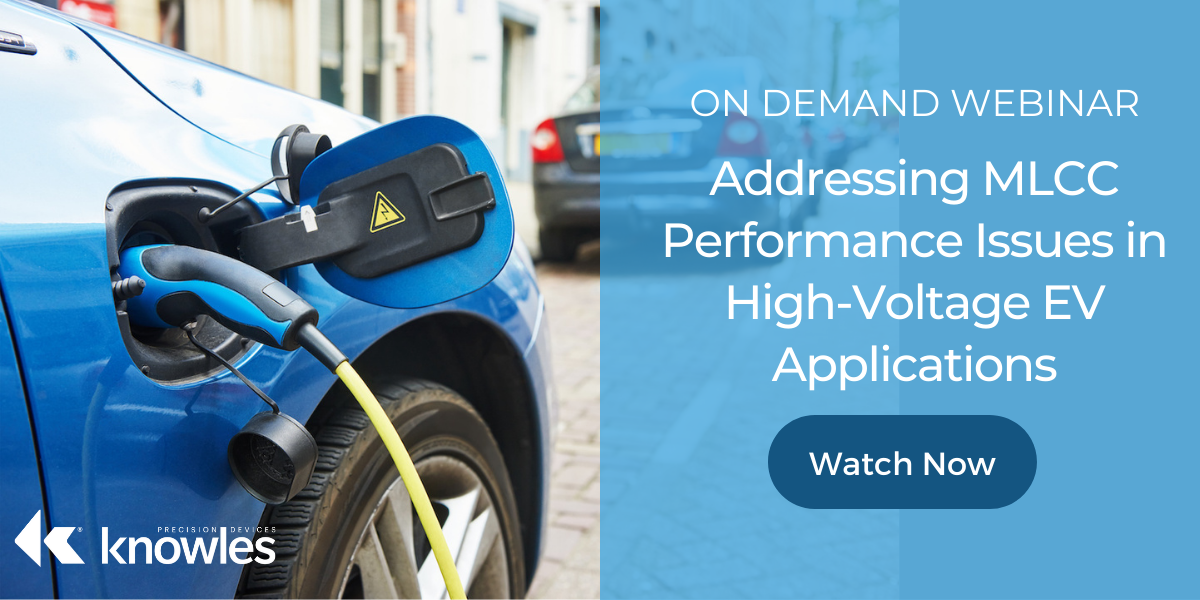Webinar: Addressing MLCC Performance Issues in High-Voltage EV Applications

In recent years, multilayer ceramic capacitors (MLCCs) have emerged as an excellent capacitor option for the high-power electrical systems needed in electric vehicle (EVs) due to their small physical size, low inductance, and ability to operate at higher temperatures. However, EV engineers are facing two big challenges with using MLCCs including DC bias that can cause capacitance loses of 80 to 90 percent of their quoted value and self-heating issues from AC ripple that can lead to inefficiencies in circuits as well as increased cooling demands.

These MLCC performance issues related to capacitance loss from DC bias and self-heating due to AC ripple are currently hot topics for electrical engineers working on EVs. This is largely because EV battery system efficiency can be greatly improved if capacitance loss and self-heating issues are eliminated. Not only is battery and charging efficiency important to consumers, but from an engineering perspective, if the battery can run cooler, the number of parts needed to cool the system can be reduced, lowering the weight of the vehicle. And, anytime weight is brought down, aerodynamic drag is reduced and less energy is needed to drive the vehicle, inherently increasing the vehicle’s range.
Therefore, to take advantage of all the benefits of MLCCs without causing inefficacies elsewhere, EV engineers need a way to eliminate these issues. This can be done using more stable materials, such as the custom materials offered by Knowles Precision Devices, that offer lower loss and less temperature rise with AC current flow. We’ve put together this webinar that was originally broadcast live with Charged EVs, to dive into these MLCC inefficiency issues and the ways to address these issues. By watching this webinar, you will learn the following:
How capacitance changes with applied voltage
The rules you need to follow to avoid overvoltage
Performance characteristics of various dielectrics
How new high-stability, low-loss materials can address these known performance issues
- +1 Like
- Add to Favorites
Recommend
- Ultra-low Capacitance TVS TEP0502TWL With Typical Capacitance of 0.2pF Only Protects Two High-speed Data Lines
- ESD Protection Diode ESDSLVU2.8-4-H, Features Integrated Low Capacitance Compensation Diodes that Reduce the Typical Capacitance to 2pF Per Line
- 0.75pF Low Capacitance TVS Diode with 80V Operating Voltage
- Nippon Chemi-Con Developed RWU/RWX Series High-Capacitance Screw Terminal Type Aluminum Electrolytic Capacitors with 50% Higher Capacitance
- ESD Protection Diode ESDULC3V3D8 with Excellent Clamping Capability, Low Capacitance, Low Leakage and Fast Response Time
- Keysight‘s Capacitance Meter: A Useful Instrument on a Test Engineer‘s Desk
- 0.6pF Ultra Low Capacitance TVS Diode Ideal for High-Speed Data, Signal, Communication Equipment, and VCC Bus
- Nippon Chemi-Con Developed LBK Series Lead Type Aluminum Electrolytic Capacitors with 44% Larger Capacitance for Automobile SRS Airbags
This document is provided by Sekorm Platform for VIP exclusive service. The copyright is owned by Sekorm. Without authorization, any medias, websites or individual are not allowed to reprint. When authorizing the reprint, the link of www.sekorm.com must be indicated.





























































































































































































































































































































































































































































































































































































































































































































































































































































































